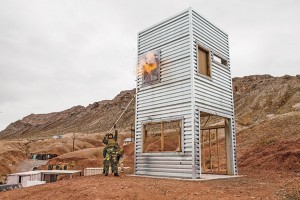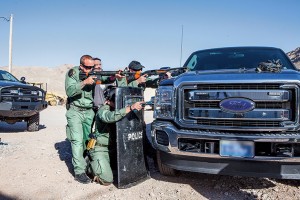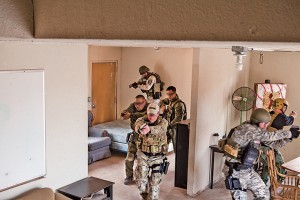Meet the 40-Man Zebra Unit Whose Stripes Get Earned and Tested to the Extreme

S.W.A.T. These letters set the mind churning, conjuring images of black-clad supermen bristling with weapons and equipment leaping through windows and blowing doors off hinges, then performing a delicate yet violent ballet as they overwhelm their objective with the goal of saving the innocent and punishing the guilty. Not too long ago, I spent a week in an intermediate SWAT course with the Las Vegas Metropolitan Police Department (LVMPD), and I can tell you firsthand that, with the exception of the black uniforms, when you imagine SWAT, these are the guys you see in your mind’s eye.
The LVMPD covers all of the unincorporated areas of Clark County, and as such it is responsible for a lot more than just that glittering island in a sea of desert. Las Vegas itself is a mere 140 square miles, a tiny piece of Clark County’s sprawling 8,091 square miles. Clark County has a normal population of two million, but in 2011 over 36.5 million people visited Las Vegas alone. With every kind of landscape and terrain — from mountaintops to rivers, deserts, cities, the Hoover Dam and countless other environments — the 40 men of the LVMPD’s Zebra Unit, or simply “Z,” are indeed those supermen, and once a year they invite tactical officers from around the country to come learn how they do it. In 2013, I was lucky enough to be able to attend and see Zebra Unit in action.

TEAM TACTICS
This article is not just a chance to sum up the five days of exceptional training that Zebra provided, but some of the topics covered by the over 250 years of SWAT experience that the instructors share: high-risk search-warrant service, active-shooter responses, hostage rescues, vehicle assaults (both cars and buses), downed-officer rescues, containment, explosive breaching, and slow and methodical team tactics. This is a lot of information to get downrange in five days, but the caliber of Zebra’s instructing officers allowed us to drink heartily from this firehose of knowledge. Oh, and let’s not forget that we had the requisite shoot-off for our class’s Top Gun spot.
As I said, this was not a basic SWAT course. Everyone who attended serves as a tactical officer, and as such, we were expected to arrive with the required skills. Zebra’s mission during the week was to tell, show, teach and assist us in learning how they do it, because they do it right, and anything we could take back to our home agencies would only help us do our jobs better and safer.
The four- and five-man active-shooter response tactics I saw during the training are the best I have seen, period. Patrol officers are taught and updated so that they can either form their own cells as the first responders, or they can be folded in with SWAT members as they arrive, in a cohesive and effective tool to mitigate the horror that is today’s active-shooter scenario. Search warrants (Vegas style) opened my eyes to the world of entry-team officers working in pairs. No more “You go left, and I’ll go right” in my world. Now I understand how to flow into and through a space with my partner, addressing all threats with a speed and level of mutually supporting cover that was previously lacking in my tactical toolbox.
Explosive breaching really goes hand in hand with hostage rescues. When it comes to high explosives, there is a very small margin for error, and I can tell you I have not even heard about anyone who breaches better then Vegas. With over 250 operational explosive breaches under their belts, these guys are surgeons. Their backup plans have backup plans, and when a hostage is in imminent danger, Zebra gets inside like greased lightning, and their ability to dominate spaces, mitigate threats and remove hostages from harm’s way is awe-inspiring.
When called upon to rescue a downed officer — either a patrol officer or a team member who goes down during an operation — things tend to get rushed and thrown together. Not so in Clark County. The rescue drills are methodically analyzed, tested, modified, retested and practiced to a level of competence that makes me think that if I ever get shot and cannot self-evacuate, I hope these guys are coming to get my bacon out of the fire. If I can get just one thing that I bring back from this course implemented at my agency, I hope it is the downed-officer rescue training I learned while there.
Containment may not seem very sexy, but it really is the most important aspect of tactical operations after a successful P# 13647 entry. It turns out that there is a whole lot more science and procedure to it than I used to think. It is a vital component and needs to be carried out by highly competent SWAT officers, not passed off to patrol as an additional duty.

Vegas Metro SWAT has pretty much done it all, but they are happy to say that they have never had to do a bus takedown. They train like hell for it, though, and have come up with a definitive plan for every type of bus in their jurisdiction. But I can tell you that if someone is ever dumb enough to take hostages on one in Zebra’s neck of the woods, I am sure it will be a much worse day for the bad guys than it will be for the hostages. Their standard passenger vehicle takedowns are a sight to see. From the approaches to breaking windows and apprehending suspects, the tactics we learned did not miss a beat.
All that and more was crammed into five days of classroom, range and field training. If not for the unbelievable competence and professionalism of our instructors, there is no way any of us would have been able to retain the sheer volume of data to which we were exposed. Day five was exercise day, which saw us broken up into operational teams and given the brief on our next obstacle. Then it was up to us to devise the plan and execute. The exercises involved schools, vehicles, hostages and search warrants — all with more role players than expected — not to mention flashbangs, K-9 units and a sense of urgency that you don’t usually find in training scenarios. We spent our last day thinking, planning, attempting, readjusting and learning. Our cadre of teachers was there every step of the way to observe so that in the after-action reports we actually got the “take homes” as far as lessons learned, ensuring that we implement these tactics, techniques and procedures (TTPs) in the real world.
TIER ONE SWAT
People from all over the world come to Vegas to play, to act in ways they never would at home and to explore the world of excess. There is another contingent that comes here — those who put their lives on the line so that others may live. Vegas is a mecca of tactics and thought-provoking innovation in this constantly evolving world. Operators from every organization come to share thoughts, ideas and capabilities with Vegas Metro SWAT, and there is good reason. In the community of nonfederal law enforcement, the LVMPD’s Zebra Unit is, without a doubt, Tier One. Their absolute commitment to excellence is unparalleled; men train and wait years for a coveted spot on the team. Some of the instructors have been with Zebra for more than 20 years operationally.
The 40 men of Zebra average over 350 high-risk warrants and 50 hostage rescues a year. I’m not sure about yours, but that is a pretty serious operational tempo in my world. One thing that was repeated over and over to us was that they were there to teach us how they do it; our job was to take from this course a new set of tools that we could incorporate into our departments as needed and where applicable. These lessons we were taught were not based on ego, but instead on real-world application and testing. The men of Zebra were not trying to make us clones of them, either. As true professionals, they trusted us with their hard-earned knowledge so that we could better ourselves. I can tell you that every attendee of the 2013 course left a better, more capable officer than when he arrived.

To close out this brief view of our experience in Vegas, there are a few more things you might want to know. Our instructors were not sent to teach; they remained operational the entire time we were there. Warrants were served and rescues were made while we were trying to get some sleep at night. The sacrifices made by the teaching cadre were huge. They weren’t just burning the candle at both ends — they tossed it into an incinerator.
The Top Gun of our class went to a lieutenant whom I personally would only want to get into a fight with if he was on my side. We had another interesting classmate, the new commanding officer of Zebra itself, who was there to make sure he knew his men’s capabilities. No special consideration was given; he attended as an operator just like the rest of us. In some casual conversations with him, I found out that he was with us after just completing the breaching course and the negotiator program, and there was no rest in sight for him, with sniper school next on his agenda. It is rare to have a commanding officer with such commitment to not only be aware of how his men operate, but to earn the qualifications to jump into a stack and have his men trust him without reservation because he has put “boot to ass” and earned the right to bear the Zebra name. Zebra has been doing it a long time, and I can tell you that Vegas is in good hands.
We live in a world where we can never know enough. And while there is no “one-stop shopping experience” for a SWAT officer, the LVMPD’s Zebra Unit is as close to a megastore as you will find.
This article originally appeared in Tactical Weapons May/June 2015 and is reprinted here by permission of Harris Publications. For ordering information, please visit harristacticalstore.com.

